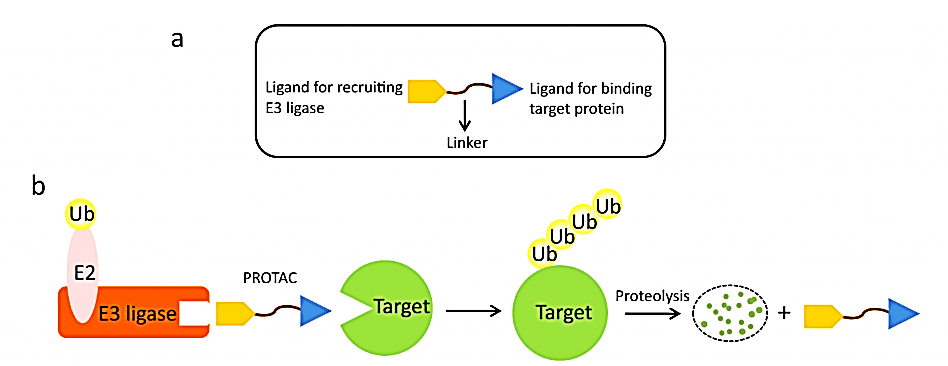Background
PROTAC® (Proteolysis Targeting Chimeria) is a special protein degradation technology. PROTAC technology uses the ubiquitin proteasome pathway, a natural protein degradation pathway in cells, to remove specific proteins that need to be degraded. Proteins with abnormal structure or function in cells are labeled with polyubiquitin by a series of enzymes (ubiquitin enzyme E1, E2, E3), and then transferred to the proteasome for degradation.
A PROTAC molecule consists of two key domains: a domain that binds specifically to the target protein to be degraded, and a domain that binds to E3 ubiquitin ligase, which is connected by a specific linker. PROTAC connects the target protein to E3 ubiquitin ligase through the above two key domains, and ubiquitin is transferred to the target protein to achieve the ubiquitination of the target protein. After multiple rounds of ubiquitin, there are multiple ubiquitin tags, and the target protein after polyubiquitin will be recognized by the proteasome and degraded.

In 2008, the first small molecular PROTAC protein degradation agent was reported. Its E3 binding ligand is MDM2-p53 inhibitor nutlin, protein targeting part is selective androgen receptor regulator SARM, uses MDM2 containing E3 to induce AR degradation, thus opening a new era of PROTAC technology development. Small molecular PROTAC protein degradants overcome the shortcomings of poor permeability and low cell activity of the first generation peptide Protacs cells and are relatively easier to be absorbed by the human body. ARV-110 and ARV-471, which first entered the clinic in 2019, are typical representatives of small molecular PROTAC protein degradants.
The Advantages of PROTAC
Compared with traditional protein inhibition methods, the PROTAC method has many advantages. Inhibitors require continuous protein binding to cause the expected biological response. This may be problematic in terms of target overexpression, the presence of competitive ligands, or the incidence of protein mutations that lead to binding resistance. The PROTAC model bypasses these problems by promoting degradation to bypass the natural resistance of proteins to persistent inhibition. In theory, it only needs to catalyze the number of drugs to degrade almost all proteins (including membrane proteins) in cells, so it has high safety, drug resistance, and broad application prospects.
Conclusion
The development of new drugs for ubiquitin protein degradation marks the rise of a new field of small molecule drug research. BOC Sciences provides E3 ligase ligands, ligand-linker conjugates, target protein ligands, sniper and intact PROTAC molecules to makes it possible to develop a vast array of Protacs for drug discovery.
References:
- Paiva, S. L., & Crews, C. M. (2019). Targeted protein degradation: elements of Protac design. Current opinion in chemical biology, 50, 111-119.
- Testa, A., Hughes, S. J., Lucas, X., Wright, J. E., & Ciulli, A. (2020). Structure‐Based Design of a Macrocyclic Protac. Angewandte Chemie, 132(4), 1744-1751.



